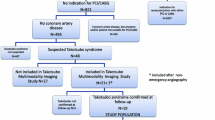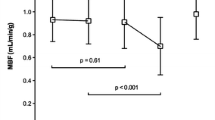Abstract
Purpose
The purpose of this study was to compare contrast-enhanced MRI and nuclear imaging with 99mTc-tetrofosmin and 18F-fluorodeoxyglucose (18F-FDG) single photon emission computed tomography (SPECT) for assessment of myocardial viability.
Methods
Included in the study were 60 patients with severe ischaemic left ventricular (LV) dysfunction who underwent contrast-enhanced MRI, 99mTc-tetrofosmin and 18F-FDG SPECT. Myocardial segments were assigned a wall motion score from 0 (normokinesia) to 4 (dyskinesia) and a scar score from 0 (no scar) to 4 (76–100% transmural extent). Furthermore, 99mTc-tetrofosmin and 18F-FDG segmental tracer uptake was categorized from 0 (tracer activity >75%) to 3 (tracer activity <25%). Dysfunctional segments were classified into viability patterns on SPECT: normal perfusion/18F-FDG uptake, perfusion/18F-FDG mismatch, and mild or severe perfusion/18F-FDG match.
Results
Minimal scar tissue was observed on contrast-enhanced MRI (scar score 0.4±0.8) in segments with normal perfusion/18F-FDG uptake, whereas extensive scar tissue (scar score 3.1±1.0) was noted in segments with severe perfusion/18F-FDG match (p < 0.001). High agreement (91%) for viability assessment between contrast-enhanced MRI and nuclear imaging was observed in segments without scar tissue on contrast-enhanced MRI as well as in segments with transmural scar tissue (83%). Of interest, disagreement was observed in segments with subendocardial scar tissue on contrast-enhanced MRI.
Conclusion
Agreement between contrast-enhanced MRI and nuclear imaging for assessment of viability was high in segments without scar tissue and in segments with transmural scar tissue on contrast-enhanced MRI. However, evident disagreement was observed in segments with subendocardial scar tissue on contrast-enhanced MRI, illustrating that the nonenhanced epicardial rim can contain either normal or ischaemically jeopardized myocardium.




Similar content being viewed by others
References
Rahimtoola SH. The hibernating myocardium. Am Heart J 1989;117:211–21.
Allman KC, Shaw LJ, Hachamovitch R, Udelson JE. Myocardial viability testing and impact of revascularization on prognosis in patients with coronary artery disease and left ventricular dysfunction: a meta-analysis. J Am Coll Cardiol 2002;39:1151–8.
Bax JJ, Cornel JH, Visser FC, Fioretti PM, van Lingen A, Reijs AE, et al. Prediction of recovery of myocardial dysfunction after revascularization. Comparison of fluorine-18 fluorodeoxyglucose/thallium-201 SPECT, thallium-201 stress-reinjection SPECT and dobutamine echocardiography. J Am Coll Cardiol 1996;28:558–64.
Bax JJ, van der Wall EE, Harbinson M. Radionuclide techniques for the assessment of myocardial viability and hibernation. Heart 2004;90(Suppl 5):v26–33.
Cornel JH, Bax JJ, Fioretti PM. Assessment of myocardial viability by dobutamine stress echocardiography. Curr Opin Cardiol 1996;11:621–6.
Kim RJ, Wu E, Rafael A, Chen EL, Parker MA, Simonetti O, et al. The use of contrast-enhanced magnetic resonance imaging to identify reversible myocardial dysfunction. N Engl J Med 2000;343:1445–53.
Isbell DC, Kramer CM. Cardiovascular magnetic resonance: structure, function, perfusion, and viability. J Nucl Cardiol 2005;12:324–36.
Isbell DC, Kramer CM. Magnetic resonance for the assessment of myocardial viability. Curr Opin Cardiol 2006;21:469–72.
Lee VS, Resnick D, Tiu SS, Sanger JJ, Nazzaro CA, Israel GM, et al. MR imaging evaluation of myocardial viability in the setting of equivocal SPECT results with (99m)Tc sestamibi. Radiology 2004;230:191–7.
Kaandorp TA, Lamb HJ, van der Wall EE, de Roos A, Bax JJ. Cardiovascular MR to access myocardial viability in chronic ischaemic LV dysfunction. Heart 2005;91:1359–65.
Knuesel PR, Nanz D, Wyss C, Buechi M, Kaufmann PA, von Schulthess GK, et al. Characterization of dysfunctional myocardium by positron emission tomography and magnetic resonance: relation to functional outcome after revascularization. Circulation 2003;108:1095–100.
Kühl HP, Beek AM, van der Weerdt AP, Hofman MB, Visser CA, Lammertsma AA, et al. Myocardial viability in chronic ischemic heart disease: comparison of contrast-enhanced magnetic resonance imaging with (18)F-fluorodeoxyglucose positron emission tomography. J Am Coll Cardiol 2003;41:1341–48.
Kühl HP, Lipke CS, Krombach GA, Katoh M, Battenberg TF, Nowak B, et al. Assessment of reversible myocardial dysfunction in chronic ischaemic heart disease: comparison of contrast-enhanced cardiovascular magnetic resonance and a combined positron emission tomography-single photon emission computed tomography imaging protocol. Eur Heart J 2006;27:846–53.
Wu YW, Tadamura E, Yamamuro M, Kanao S, Marui A, Tanabara K, et al. Comparison of contrast-enhanced MRI with (18)F-FDG PET/201Tl SPECT in dysfunctional myocardium: relation to early functional outcome after surgical revascularization in chronic ischemic heart disease. J Nucl Med 2007;48:1096–03.
Lamb HJ, Doornbos J, van der Velde EA, Kruit MC, Reiber JH, de Roos A. Echo planar MRI of the heart on a standard system: validation of measurements of left ventricular function and mass. J Comput Assist Tomogr 1996;20:942–9.
van der Geest RJ, Buller VG, Jansen E, Lamb HJ, Baur LH, van der Wall EE, et al. Comparison between manual and semiautomated analysis of left ventricular volume parameters from short-axis MR images. J Comput Assist Tomogr 1997;21:756–65.
Cerqueira MD, Weissman NJ, Dilsizian V, Jacobs AK, Kaul S, Laskey WK, et al. American Heart Association Writing Group on Myocardial Segmentation and Registration for Cardiac Imaging. Standardized myocardial segmentation and nomenclature for tomographic imaging of the heart: a statement for healthcare professionals from the Cardiac Imaging Committee of the Council on Clinical Cardiology of the American Heart Association. Circulation 2002;105:539–42.
Wu E, Judd RM, Vargas JD, Klocke FJ, Bonow RO, Kim RJ. Visualisation of presence, location, and transmural extent of healed Q-wave and non-Q-wave myocardial infarction. Lancet 2001;357:21–8.
Schinkel AF, Bax JJ, Valkema R, Elhendy A, van Domburg RT, Vourvour EC, et al. Effect of diabetes mellitus on myocardial 18F-FDG SPECT using acipimox for the assessment of myocardial viability. J Nucl Med 2003;44:877–83.
Nuutila P, Knuuti MJ, Raitakari M, Ruotsalainen U, Teräs M, Voipio-Pulkki LM, et al. Effect of antilipolysis on heart and skeletal muscle glucose uptake in overnight fasted humans. Am J Physiol 1994;267:E941–6.
Bax JJ, Veening MA, Visser FC, van Lingen A, Heine RJ, Cornel JH, et al. Optimal metabolic conditions during fluorine-18 fluorodeoxyglucose imaging; a comparative study using different protocols. Eur J Nucl Med 1997;24:35–41.
Kwong RY, Chan AK, Brown KA, Chan CW, Reynolds HG, Tsang S, et al. Impact of unrecognized myocardial scar detected by cardiac magnetic resonance imaging on event-free survival in patients presenting with signs or symptoms of coronary artery disease. Circulation 2006;113:2733–43.
Kim RJ, Fieno DS, Parrish TB, Harris K, Chen EL, Simonetti O, et al. Relationship of MRI delayed contrast enhancement to irreversible injury, infarct age, and contractile function. Circulation 1999;100:1992–2002.
Bax JJ, Visser FC, Elhendy A, Poldermans D, Cornel JH, van Lingen A, et al. Prediction of improvement of regional left ventricular function after revascularization using different perfusion-metabolism criteria. J Nucl Med 1999;40:1866–73.
Bax JJ, Cornel JH, Visser FC, Fioretti PM, van Lingen A, Nuitink JM, et al. Prediction of improvement of contractile function in patients with ischemic ventricular dysfunction after revascularization by fluorine-18 fluorodeoxyglucose single-photon emission computed tomography. J Am Coll Cardiol 1997;30:377–83.
Bax JJ, Patton JA, Poldermans D, Elhendy A, Sandler MP. 18-Fluorodeoxyglucose imaging with positron emission tomography and single photon emission computed tomography: cardiac applications. Semin Nucl Med 2000;30:281–98.
Klein C, Nekolla SG, Bengel FM, Momose M, Sammer A, Haas F, et al. Assessment of myocardial viability with contrast-enhanced magnetic resonance imaging: comparison with positron emission tomography. Circulation 2002;105:162–7.
Bove CM, Dimaria JM, Voros S, Conaway MR, Kramer CM. Dobutamine response and myocardial infarct transmurality: functional improvement after coronary artery bypass grafting – initial experience. Radiology 2006;240:835–41.
Author information
Authors and Affiliations
Corresponding author
Rights and permissions
About this article
Cite this article
Roes, S.D., Kaandorp, T.A.M., Ajmone Marsan, N. et al. Agreement and disagreement between contrast-enhanced magnetic resonance imaging and nuclear imaging for assessment of myocardial viability. Eur J Nucl Med Mol Imaging 36, 594–601 (2009). https://doi.org/10.1007/s00259-008-1001-0
Received:
Accepted:
Published:
Issue Date:
DOI: https://doi.org/10.1007/s00259-008-1001-0




